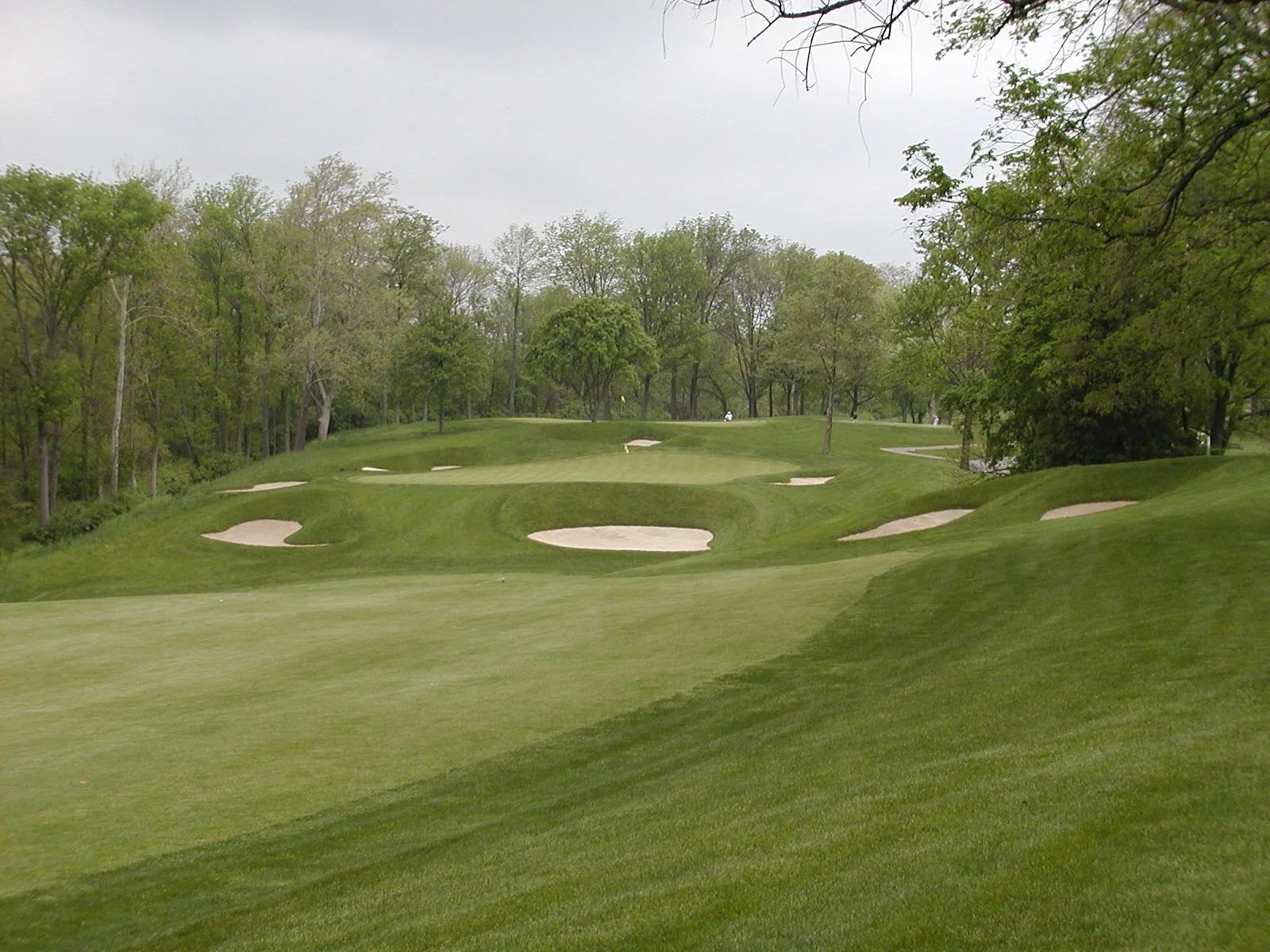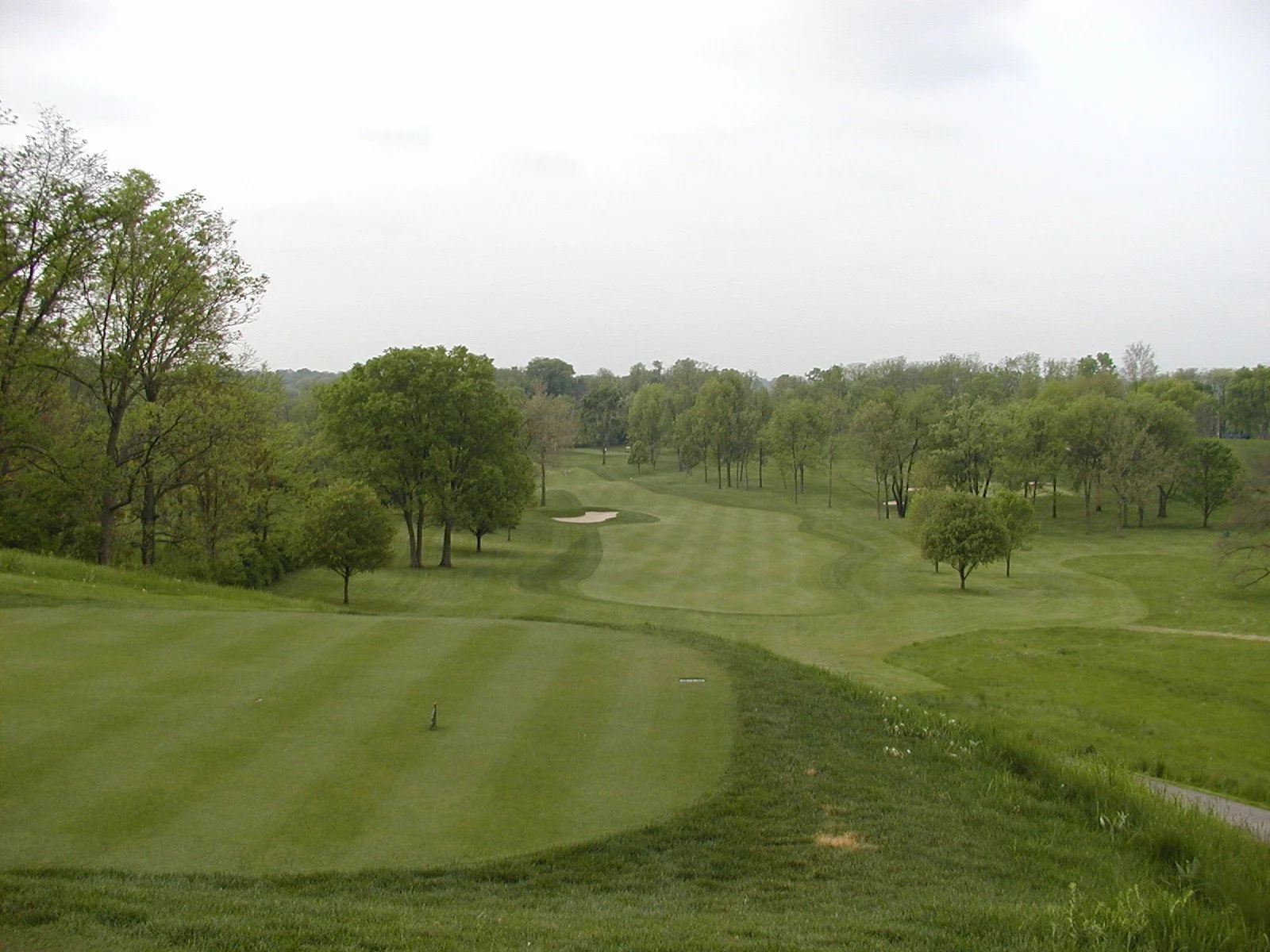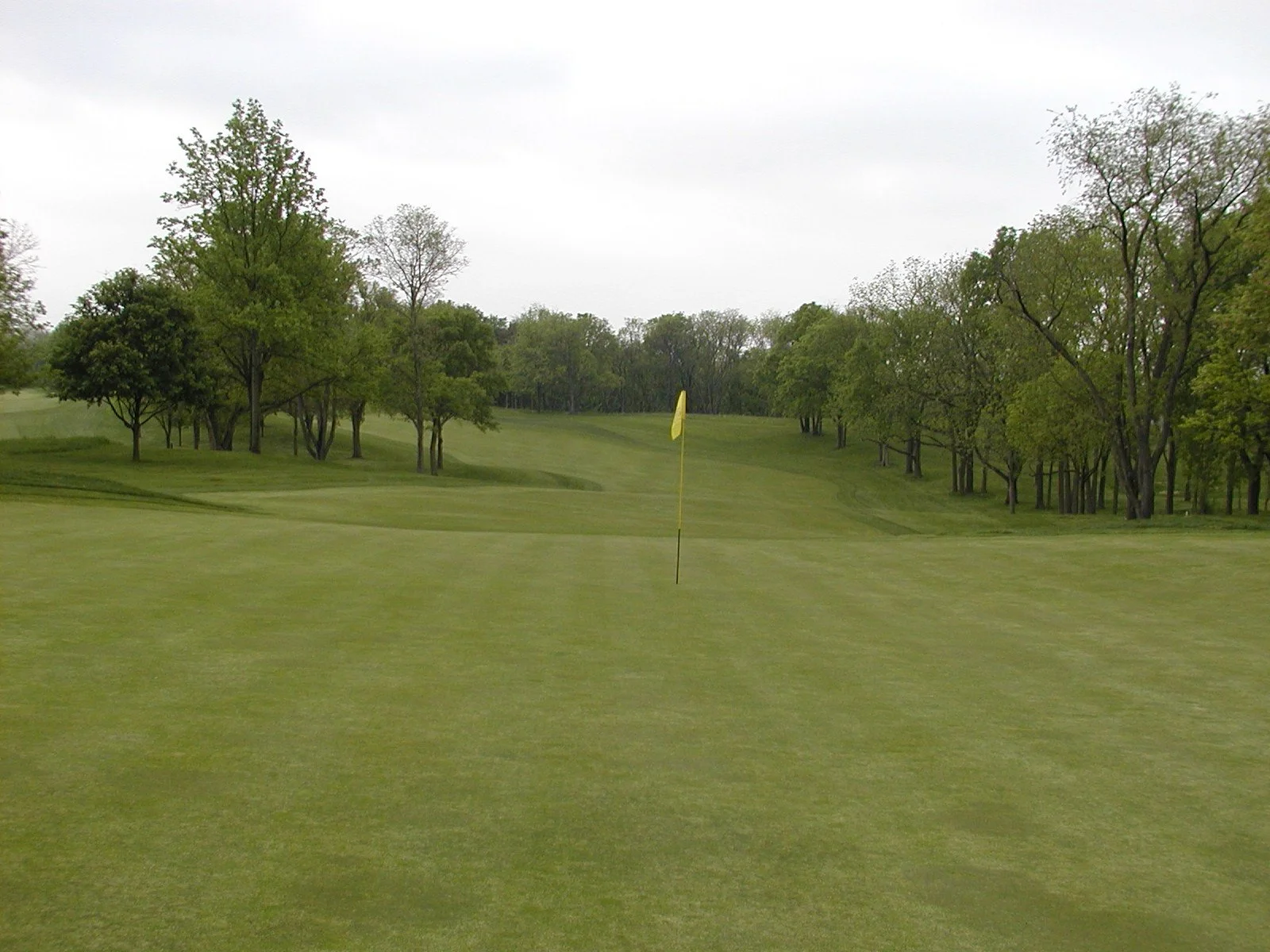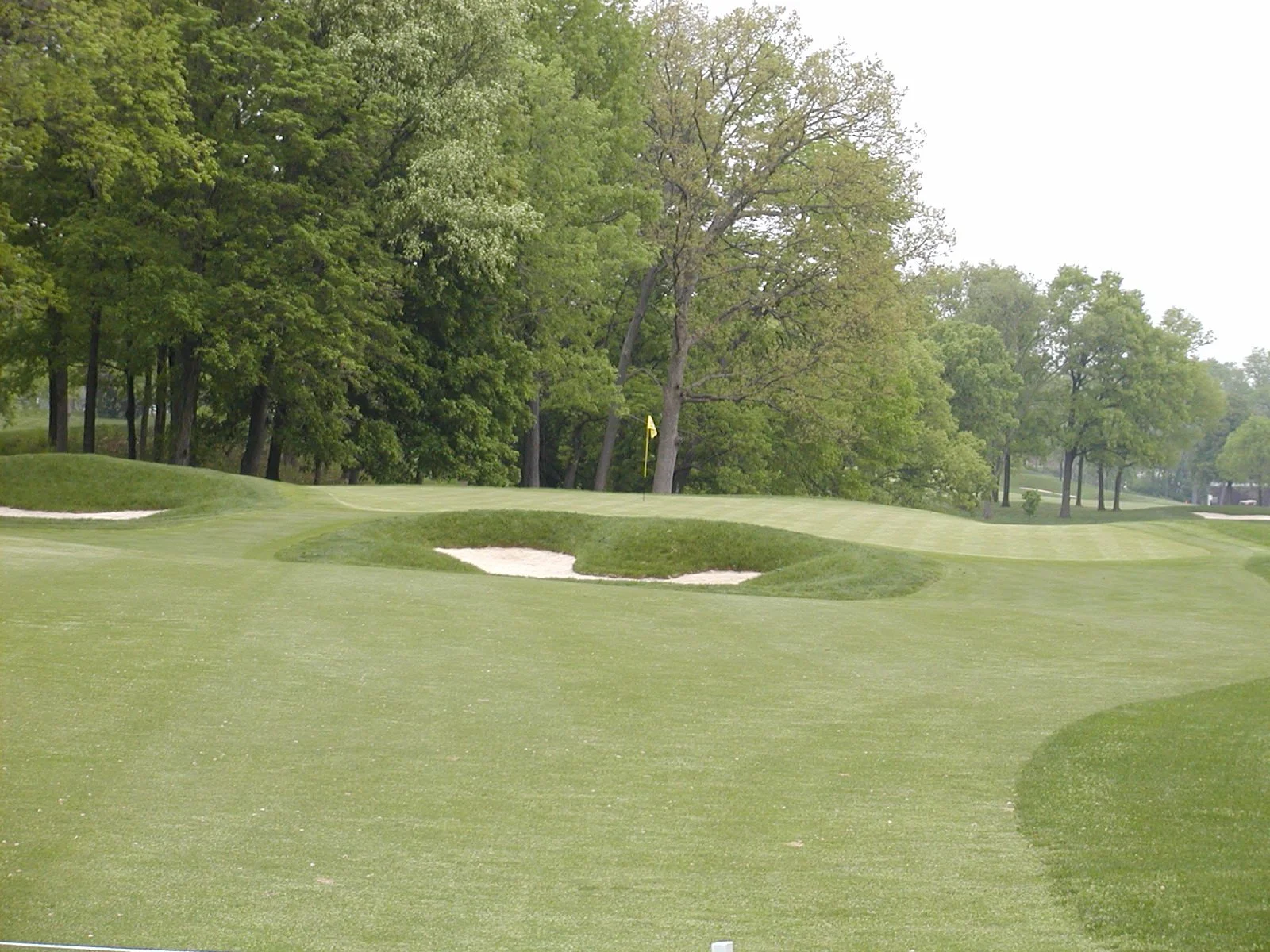NCR COUNTRY CLUB (SOUTH)
Course Architect: Dick Wilson
Year Opened: 1954
Location: Kettering, Ohio
Slope: 139. Rating: 74.5
Par: 71
Yardage: 7,055
Hole-by-Hole: 1 - Par 4 452 Yds 10 - Par 5 548 Yds
2 - Par 3 174 Yds 11 - Par 4 383 Yds
3 - Par 4 432 Yds 12 - Par 4 460 Yds
4 - Par 4 390 Yds 13 - Par 3 204 Yds
5 - Par 5 558 Yds 14 - Par 4 401 Yds
6 - Par 5 552 Yds 15 - Par 3 234 Yds
7 - Par 4 428 Yds 16 - Par 4 453 Yds
8 - Par 3 172 Yds 17 - Par 4 352 Yds
9 - Par 4 441 Yds 18 - Par 4 421 Yds
Par 36 3,599 Yds Par 35 3,456 Yds
Key Events Held: PGA Championship (1969),
U.S. Women's Open (1986),
U.S. Mid-Amateur (1998), USGA Women’s State Team (2013),
U.S. Senior Open (2005), U.S. Senior Women’s Open (2022).
Awards Won: Ranked #65 by Golfweek - America's Top 100 Classic Courses (2004),
Ranked #15 by Golf Digest - Best in State (Ohio) (2005),
Ranked #93 by Golf Digest - America's 100 Greatest Courses (2004).
Website: ncrcountryclub.com
HISTORY: It didn't take long for NCR Country Club to become a world-class golfing facility when it opened in 1954. The idea of Stanley "S.C." Allyn, president of National Cash Register Corporation, Allyn wanted a top notch club and recreational facilities for the employees of NCR. He got just that, as Allyn enlisted Florida-based architect Dick Wilson to carve out 36 holes on
350 acres owned by the NCR Employees Benefit Association.
Wilson, who later designed such memorable courses like Laurel Valley Golf Club, Doral Resorts
"Blue Monster" and Bay Hill, crafted a pair of distinctively different venues. One, a links style course (North) and the South with its tree-lined, rolling fairways, deep rough, doglegs and bunkers.
Just 15 seasons after the first tee shot was hit, NCR hosted its first major event, the PGA Championship on the South Course. Tied for the lead after round one with eight other players at
69, Ray Floyd took control of the event with rounds of 66-67 to open up a five-shot advantage with one round to play. South African Gary Player, Floyd's closest pursuer, staged a remarkable rally, as he got within one of the lead as Floyd bogeyed 13 and 15.
Player dropped back with a bogey on 16 and despite a birdie at 17, the "International Ambassador of Golf," could do no better than 70 and finished one back. Floyd's final round of 74 still ranks as the highest final-round score by a winner. The win was the first of four major championships for Floyd and one of his 22 career PGA Tour titles.
NCR South proved to be the big winner, however, as the stroke average for the week was 73.62 with the halfway cut at eight-over par. Next up was the U.S. Women's Open of 1986, as Jane Geddes outlasted Sally Little in a playoff for her first career victory. Geddes, an 11-time winner on the LPGA Tour, trailed third-round leader Betsy King by five shots with only 18 holes remaining. With 11 consecutive pars and birdies on 12 and 14, Geddes moved to within two of the lead, tying Little for second. Following a Little birdie and a King double-bogey, Geddes trailed by one, as Little claimed the top spot. Geddes capped off her bogey-free round of 69 with a birdie on 17 to move into a tie with Little and force a playoff.
After four holes, the duo were tied, however Little birdied the next three holes to take a 3-up advantage with just 11 holes remaining. The lead was short-lived however, as Geddes made birdie on eight while Little made bogey and then on nine Little made double-bogey and the lead was by one for Geddes. Little fought back however with a birdie on 10 to draw even, however Geddes took the lead for good with a birdie on 14, as she went on to pocket $50,000. Geddes, who opened with rounds of 74-74, closed with three sub-par rounds of 70-69-71. Her five-stroke reversal is tied for
the best comeback by a winner in a final round in U.S. Women's Open history. Geddes and Little were the only players in the field to finish regulation under par (one-under).
The next United States Golf Association event to be held at NCR was the 1998 U.S. Mid-Amateur Championship. With over 4,000 entries, it came down to John "Spider" Miller and Chip Holcombe for the title of this event which allows amateur players 25 and older with a handicap index of 3.4 or lower to compete.
A beer distributor and the winner of this event two years prior, Miller birdied holes six through eight to take a lead he would never relinquish, as he defeated Holcombe, 1-up. At the time, Miller became the oldest winner of this championship at 48 years young.
The club has not rested on its laurels, as a 40,000 square-foot clubhouse was built in the '90s, a 4,000 square-foot pool and fitness complex was completed in 2001 and the golf shop was renovated in 2004. Let's not forget the two driving ranges, putting greens and chipping areas along with an indoor practice facility for the off season.
The USGA returned in 2005 for the U.S. Senior Open, as Allen Doyle defeated Loren Roberts and D.A. Weibring by one shot for his third Champions Tour major title. Doyle, who started the final round nine shots behind Roberts, carded a 8-under-par 63 to set a new record for largest final-round comeback in Senior Open history. Weibring held a one-shot lead with two holes remaining, but made bogey on 17 and 18 to tie Roberts for second. Greg Norman, in only his second event on the Champions Tour, finished alone in fourth place.
The fourth staging of the U.S. Women’s Senior Open was held at NCR South in 2022. Jill McGill edged Leta Lindley by one shot, finishing at 3 under par. How good was NCR, no one broke par in the final round!
COURSE REVIEW: Many courses are designed with gentle first holes to get the player in the swing of things, so to speak, not NCR South. The opening four holes, three of which rank in the top-five as toughest on the course, will set the tone for the remainder of your round. The opening hole is the No. 1 handicap, stretching 452 yards from the black tees. The fairway slopes left to right
with trees covering the entire left side to the green. Even after a big tee shot, a mid to long iron will be required to reach the putting surface. The green is guarded, front-left by sand and with a pair of bunkers in the rear. Just 35 yards in depth, the green slopes from front to back and left to right, so making par here might be a tall order right out of the box.
Your iron play will certainly be tested on the second hole, a par three of 174 yards in length. The putting surface is quite narrow, 35 yards deep, multi-tiered and is slightly uphill. Throw in bunkers, left, right and in front and you have a hole that requires perfect club selection if you're to make par.
The third hole typifies NCR South, with its elevated tee box, majestic trees and contoured fairways. Your tee shot plays downhill to the fairway, as the hole doglegs to the right, so the best play is a fade or bomb over the corner of the trees. Although the distance will be roughly 150 yards, your approach will play severely uphill to the green, adding one to two clubs to your shot. The
putting surface is quite slick, as it slopes from back to front, so at all costs, miss below the hole. Par or even bogey is a good score.
Three-metal is all that is needed to attack the par-four fourth. Another dogleg to the right, the hole is protected at the corner by a pair of deep bunkers and woods, while the left side features additional lumber. Success off the tee will leave only a short iron or wedge to one of the longest greens on the course at 47 yards in length. The surface slopes from front to back and is guarded in the front by sand, as well as a deep trap on the left.
Holes five and six are back-to-back par fives of 558 and 552 yards, respectively. The key on the fifth is the slightly uphill tee shot, which must navigate through a chute of trees to reach the fairway. Three-metal will be the club of choice to reach in two, but be wary of the bunkers left and right of the surface, which make for a difficult up and down. The green is quite thin with a ridge in the middle. Anything worse than par is unacceptable.
The sixth is a great risk-reward hole. A drive down the right side of the tree-lined fairway can set up a chance to reach the green in two. The problem here is that if you cut off too much, you'll be left with an awkward lie on a steeply sloped bank. The second obstacle is the second shot if you dare go for the green. Numerous bunkers protect the putting surface, including the front trap which is 15 feet below the green. Long is no bargain either, as the green slopes severely from back
to front. With that in mind, the hole can be had with a front pin, so layup short, hit your third deep with a wedge and let the slope carry it to the flag as you make birdie.
The seventh is yet another testy dogleg right par four. First off, your tee shot must cut the corner to set up the best approach to the green. Easier said then done, as trees and more trees are your main obstacle. The more you cut, the narrower the fairway becomes. A mid to short-iron remains to the smallest green on the course at just 27 yards deep. For good measure, the surface slopes from back-to-front and is surrounded by four deep bunkers. If you're not careful, you might be writing five or six on the scorecard.
The shortest hole on the course, the eighth, is probably the easiest. Despite three deep bunkers that surround the putting surface, the green is fairly wide and it slopes from back-to-front. Just a mid-iron can set up a possible birdie try, as long as you're below the hole.
The final hole on the outward nine is another pesky dogleg, this time to the left. The elevated tee box shows how you must shape your shot to avoid left-side fairway bunker and carve it inside the right tree line. A mid to long-iron, depending upon the pin placement (green is 42 yards deep), will be needed to hit pay dirt. The putting surface slopes severely from back to front and the bunkers surrounding the green are quite deep. Miss long with a front flag and you run the risk of putting right off the green.
The back nine opens with the final par five on the course, a beautiful dogleg right gem. Your tee shot plays uphill with sand protecting the corner, so you must challenge for position to make birdie. From the top of the hill, the 10th now slopes downhill towards the green, with an uphill rise 60 yards before the surface. Bunkers galore blanket this green, that slopes from back to front. Playing below the hole on the second smallest green on the course will set up a birdie try, or better yet...eagle.
Another hole that requires a strategic drive is the 11th. Although just 383 yards in length, this par four, that turns to the left and plays uphill, demands a draw over the fairway bunker to set up a short iron. The hard part now becomes club selection and accuracy, as the putting surface is quite narrow and deep (40 yards). The green is tiered and guarded tightly by bunkers. Even though the 11th is the second shortest par four on the course, it ranks as the sixth handicap hole, so don't
be disappointed with bogey.
The most difficult hole on the back nine is without question, the par-four 12th. Standing on the elevated tee box, don't be caught off guard, as you look out upon the beauty of NCR. A demanding, accurate and long tee shot is needed on this 460-yard monster that bends to the left. The further your opening shot is hit, the tighter the fairway becomes. From the rolling fairway, an uphill approach remains, to a deep, narrow green that falls away to the left and front. Sand awaits the errant second, both left and right, making this one bear of a hole.
It doesn't get any easier at the par-three 13th. This could be the hardest green on the course, as it slopes from left to right and front to back. With the firmness of the green along with the slope, a long iron will be almost impossible to hold the surface.
The so-called easiest hole on the course, the 14th is a downhill, dogleg left with two dozen-plus bunkers covering the fairway and the green. Three-metal is the best play off the tee, setting up a short iron to the well-guarded putting surface. Par for certain, birdie a possibility.
The final one-shotter on the course, the 15th is also the longest par three at 234 yards from the tips. Trees flank the right side while the left falls sharply downhill with two deep bunkers. The putting surface is one of the longest on the course at 46 yards and is also quite narrow. Missing this green, especially right, could result in double-bogey or worse.
Another imposing hole, the 16th, is a splendid par four that doglegs to the right and plays
downhill. Trees guard both sides of the fairway, as this par four is one of just two holes devoid of landing-area bunkers. A wide, deep green awaits your uphill approach that will require a mid to long-iron. The putting surface is slick and slopes from back to front with a pair of traps fronting the green. A classic par four if there ever was one.
In contrast, the 17th is the easiest on the course. The straightaway par four is only 352 yards in length, requiring only a long iron or fairway metal off the tee. A manageable pitch remains to a wide-open green that should set up birdie. Sand and slope are the only defense to this putting surface. Par should be the worst score you leave with.
The 18th is a perfect end to an outstanding golf course. The tree-lined fairway necessitates a long drive from the elevated tee box to reach the corner of the dogleg left. Missing left will result in sand, trees or a difficult sidehill lie in the rough with no chance of getting home. The right side is no bargain either with a pair of traps and deep rough. The putting surface is just as difficult, stretching 49 yards in length and sloping severely from back to front and left to right. Making par on this treasure will erase all of the sorrow you suffered in your round.
FINAL WORD: To hold the 2005 U.S. Senior Open, changes needed to be made to the existing layout. NCR's no-nonsense approach was just what the doctor ordered, as trees were removed for agronomy and gallery control, as well as every teeing ground being rebuilt. "Every time I come here I get more impressed," commented Tom Meeks, the USGA's former senior director of rules and competitions.
Despite dropping out of the top-100 in Golf Digest's list for 2005, NCR South will most certainly climb back into the ranks, as it has to much to offer. This course has everything a classic venue requires; length, deep rough, sloping greens, tree-lined fairways and plenty of greenside
bunkers. It just goes to show you, water is not needed to make a course difficult or demanding.
"It's a legendary golf course," mentioned 2004 Senior Open champion Peter Jacobsen. "This is not a golf course you overpower, as a lot of strategy comes into play." Great practice facilities, scenic views, perfect conditions, great hospitality and by the way, one heck of a layout.
NCR is private and you must be a guest of a member to play, so get on the phone and call in some favors, you won't be disappointed. I certainly wasn't and I can't wait to come back.
















